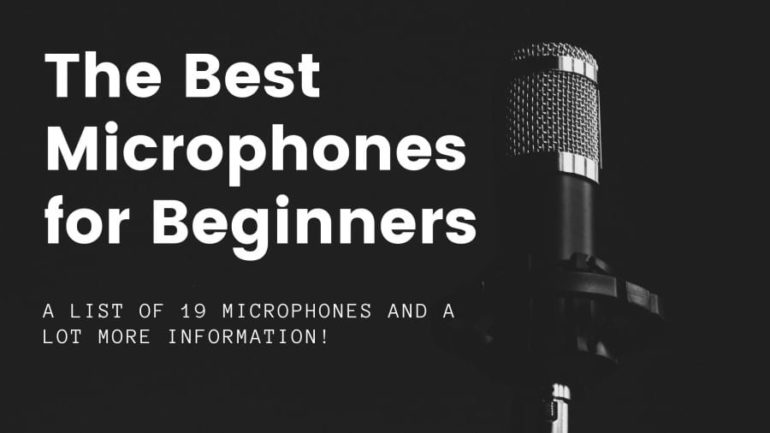Last updated on December 29th, 2023 at 09:50 pm
Have you ever walked into one of those huge music stores with the intention of buying a microphone only to be overwhelmed by the sheer number they have to offer?
In this article, I will go over a couple of microphones that should suit every beginner’s needs, starting with the USB Microphones.
Later on, I will also go over what microphones are the best ones for each purpose, and at the end of this article, I will list my three top picks for every beginner.
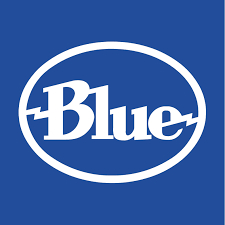
Blue Yeti
Great-sounding USB microphone that features 4 polar patterns, making it really versatile.

AT2020 USB+
Best-Sounding Cardioid USB Microphone that is good for singing, Voiceover, gaming, etc.

ElGato Wave 3
Best USB Gaming microphone: Offers a Clip Guard, Audio Mixing software, etc.
Now, without any further ado, let’s get started!
USB Microphones
USB microphones are plug n’ play devices that you connect to your PC via a USB cable and that’s it, they are working!
This means that no additional equipment like an Audio Interface, Mixer, XLR cables, etc., is required.
For absolute beginners, these are the ones I’d recommend the most because of how easy they are to use.
Let’s get started…
Blue Yeti
Most Versatile USB Microphone since it has 4 polar patterns!
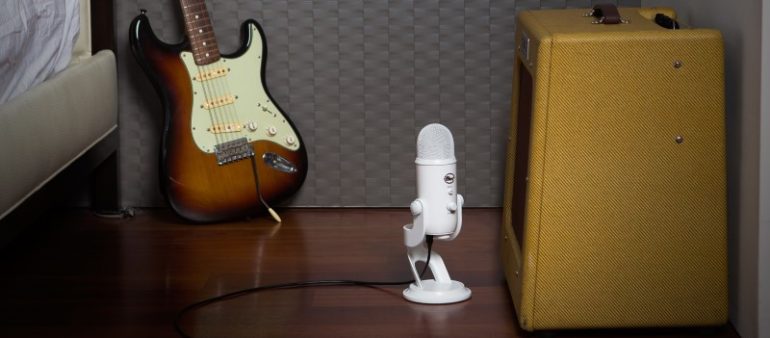
The Blue Yeti is the best-selling USB microphone currently available.
Featuring a multitude of patterns to choose from, like cardioid, omnidirectional, stereo and bidirectional, the Blue Yeti is incredibly versatile.
It is an excellent microphone for podcasters, YouTubers and Voice-over artists, but it is also an outstanding microphone for recording music.
It comes with a Gain control, a mute button, and a zero-latency headphone output.
The reason the Blue Yeti is a great option for recording music is, apart from its great sound quality, that it can record in stereo, which comes in handy when recording acoustic guitars, piano, etc.
When considering all the patterns this microphone provides, I think it’s fair to say that the Blue Yeti is the most versatile USB Microphone available, especially for the price.
Recommended for: Anyone who needs a multi-pattern microphone, for example; a YouTuber who also runs a podcast and want to use one mic to record multiple guests.
Find out more about the Blue Yeti here.
- Blue Yeti: Amazon, Sweetwater.
Audio-Technica AT2020 USB
Best-sounding USB Cardioid Condenser Microphone!

The Audio-Technica AT2020 is the go-to condenser microphone for almost every beginner home recording enthusiast.
The USB version of the AT2020 features a built-in headphone jack with volume control that allows you to directly monitor your microphone signal with no delay (Zero-latency monitoring).
It also offers a mix control that blends the microphone’s direct sound and the audio coming out of your PC.
It’s a great microphone for singer/songwriters, podcasters, voice-over artists, field recorders, and home studio owners.
While it’s definitely not as versatile as the Blue Yeti, for the simple fact that it only features a cardioid polar pattern, it does sound a lot better as well, making it my top choice out of all the microphones on this list for most people.
Recommended for: Anyone who needs the best audio quality over all.
Find out more about the AT2020 USB here:
- Audio-Technica AT2020 USB: Amazon, Sweetwater.
Note: If you’re torn between the Blue Yeti and the AT2020, then this article I wrote, where I compare both of them, is definitely for you.
ElGato Wave 3
Best USB Microphone for Gamers!
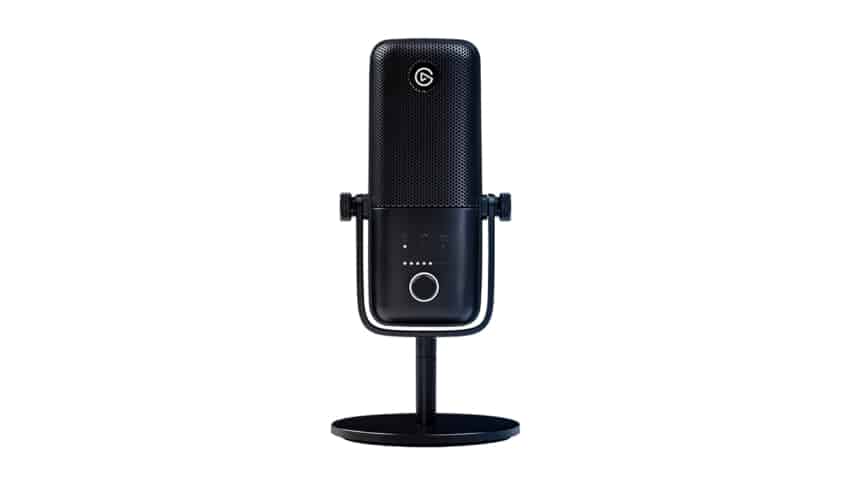
Out of all the microphones I’ve tested, the ElGato Wave 3 is by far the best Gaming & Streaming microphone currently on the market.
Not only does it sound great, comparable to the AT2020 USB in overall audio quality, but it features the Clipguard and the WaveLink software, both of which are what make it the best Gaming & Streaming microphone.
Clipguard
The Clipguard works as a Limiter, essentially limiting the volume of the signal and the volume spikes, like screams.
This means that you won’t jumpscare your viewers and the audio will never clip -or sound distorted-, yielding a great viewing experience for your stream.
WaveLink Software
Here you can mix different audio sources before they get streamed, making it easy for you to control the background music volume, game volume, etc.
You can also create a mix for you -without music, for example-, and a different one for your stream.
Recommended for: Gamers and Streamers.
Find out more about the ElGato Wave 3 here.
Large Diaphragm Condenser Microphones
Large-diaphragm condenser microphones are the most common ones you will find in any home- or professional-grade studio.
These microphones require an Audio Interface or a Mixer to be recorded and also to be powered, since they need +48v of Phantom Power to record properly.
If you don’t have an Audio Interface, check out this post I wrote about the Best ones under $300.
Let’s kick things off with one of the most popular microphones in existence;
Audio-Technica AT2020
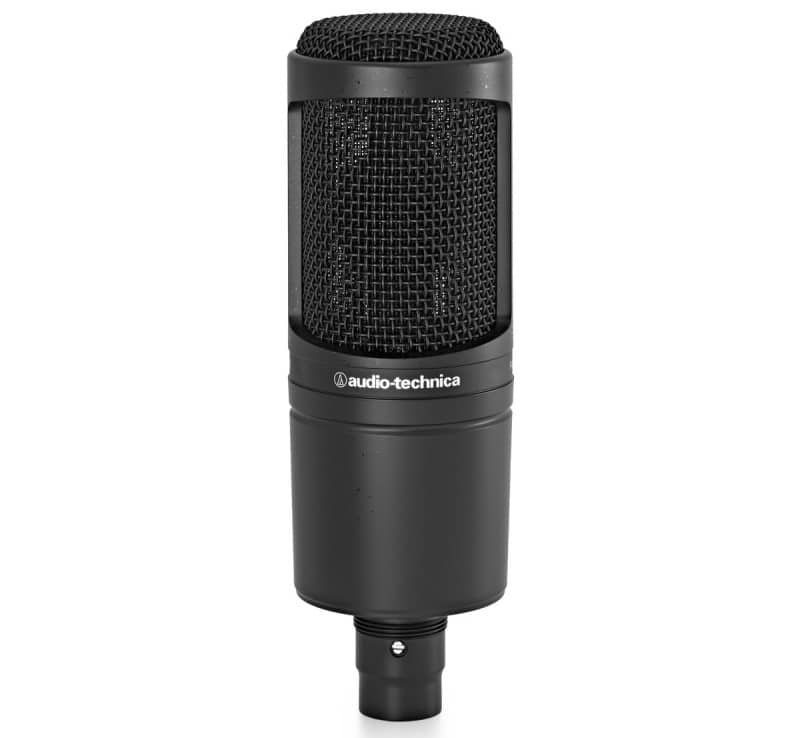
The AT2020 is probably the best-known budget large-diaphragm condenser microphone out there.
You can find at least a couple of them in every studio, which means that they should be more than enough for any beginner who is building their first home recording studio, especially if they’re on a budget.
The build quality is excellent, as you would expect from any Audio-Technica microphone, and it features a Cardioid pickup pattern.
It has a frequency response of 20Hz-20kHz and it sounds great, with a slight bump in the higher mids- and high frequencies, for some added crispiness.
Note: I mentioned this earlier, but you will need an Audio Interface that can supply phantom power to record with the AT2020.
Find out more about the Audio-Technica AT2020 here.
- Audio-Technica AT2020: Amazon, Sweetwater.
Rode NT1-A
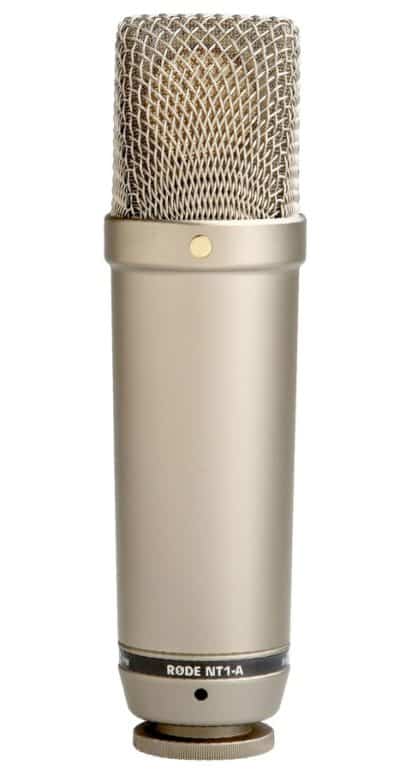
The Rode NT1-A is a fantastic mic that is built like an absolute tank, sounds fantastic, and even comes with a High-quality pop filter and shock mount, which means that you automatically save $30-$50 since you don’t need to get those.
Most large-diaphragm condenser microphones don’t even provide a regular pop filter, much less one that’s even better than most pop filters out there.
It has a fairly flat frequency response with some rounded cuts at 20-30Hz and 16k-20kHz, and a small boost in the presence frequencies, and this help your recordings to sit better in the mix without requiring as much EQ.
The Rode NT1-A offers an amazing value for the price, and you can certainly produce studio-grade music with it.
Find out more about the Rode NT1a here:
- Rode NT1a: Amazon, Sweetwater.
Audio-Technica AT4040
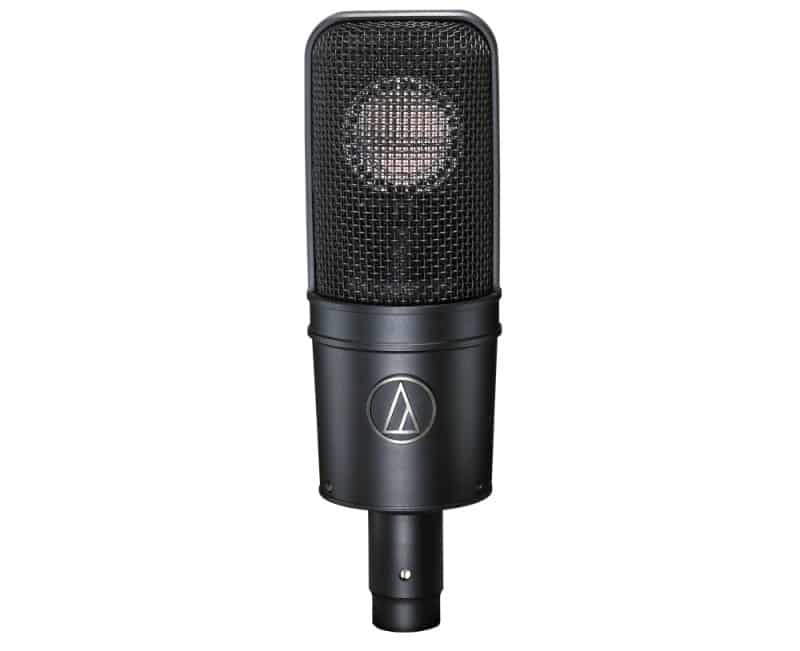
The Audio-Technica AT4040 is considered by many to be the best XLR microphone under $300.
The build quality is extremely good and comes with two switches on the back which are: A High-pass Filter, that rolls lower frequencies off at about 80Hz at 12dB/octave, and a -10dB PAD in case you are recording a really loud source.
If your recording is sounding boomy, engage the HPF and it will clear up instantly.
The great thing about the AT4040 is that it’s already a top tier microphone.
If you invest in one, then you won’t ever need to upgrade, unless you simply want to purchase another microphone to have more.
Having said that, the Rode NT1-A offers a similar recording quality at half the price, and it comes with the pop filter and the shock mount.
Find out more about the Audio-Technica AT4040 here:
- Audio-Technica AT4040: Amazon, Sweetwater.
Small Diaphragm Condenser Microphones
Small Diaphragm condenser microphones are commonly used to record acoustic instruments such as acoustic- or classical guitars, as well as piano, choirs, and drum overheads.
In most cases, I’d recommend getting a stereo pair, which simply means getting two identical microphones, more commonly referred to as “matched pairs”.
Note: Small diaphragm condenser microphones also require an audio interface and phantom power to be recorded.
Behringer C-2
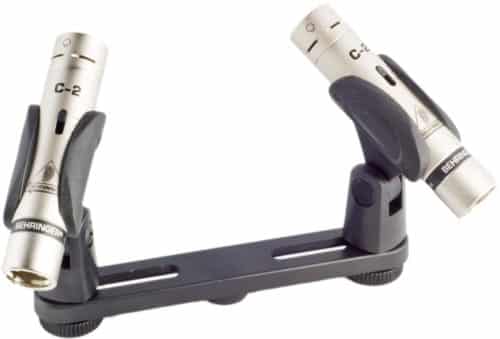
The Behringer C-2 pair is certainly good for beginners for the simple fact that you can get the pair for dirt cheap.
If you never recorded with a stereo set of microphones but want an affordable pair to get you started, this one is the way to go.
They have a small boost between 1kHz and 8kHz, meaning that they have a slightly brighter sound, which can be useful when recording overheads.
The Behringer C-2 come with a carrying case, mic-stand adapters, windscreens and more, all for a lot less than $100, offering a great value.
Find out more about the Behringer C-2 here:
- Behringer C-2: Amazon, Sweetwater.
Neewer NW-410
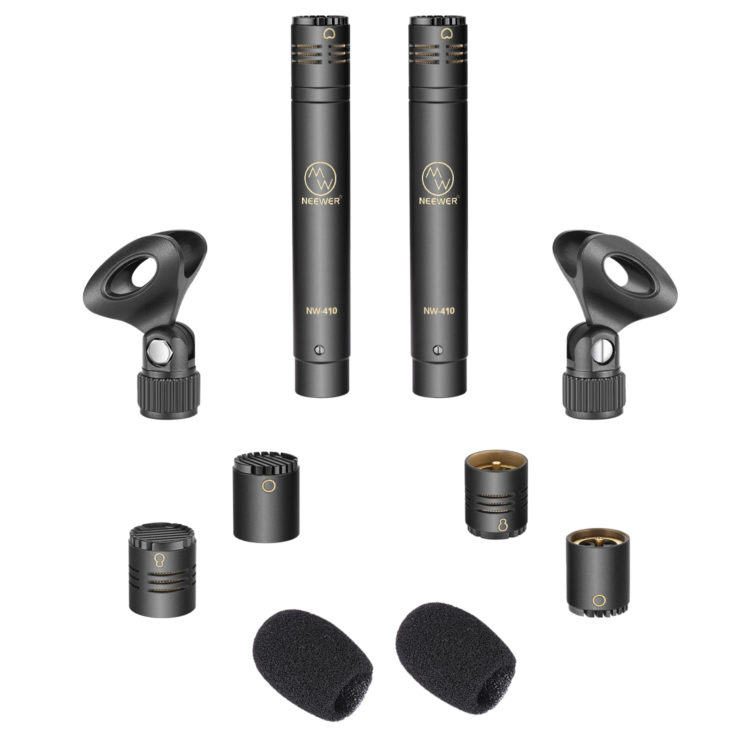
The Neewer NW-410 not only sound great, but they include three different sets of capsules, and each one has a different polar pattern; Cardioid, Omnidirectional and Supercardioid.
All of these capsules come included, but should one get damaged you can simply purchase another one and screw it on.
Included with these microphones you also get two foam windscreens, two microphone clips as well as a pretty cool aluminum carrying case.
I consider the Neewer NW-410 to be the best all-rounders when it comes to stereo pair microphones.
The price is very affordable, and the overall quality is very good, plus they come with a lot of extras which most other microphones don’t.
Find out more about the Neewer NW-410 here.
Avantone CK-1
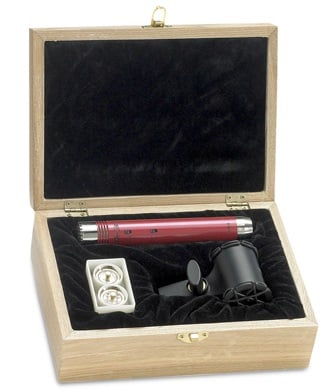
The Avantone CK-1 is a definite step up when compared to the previous two pairs, the issue is that it’s not sold as a pair, and just the one microphone costs quite a lot more than the Neewer NW-410 pair.
However, if you really want to get a good small diaphragm condenser microphone, this one’s it.
The body has a really nice-looking red finish and the build quality of the entire microphone is fantastic.
It comes in a wooden box, which is much better than the box where the Neewer NW-410 pair comes in.
The Avantone CK-1 also comes with interchangeable capsules, featuring Cardioid, Hypercardioid and Omnidirectional pickup patterns.
Also included is the shock mount, which is not a regular mic clip, and this shock mount will absorb any vibrations that may otherwise be transmitted into the mic.
Lastly, this microphone features a High-Pass filter at 80Hz and a -10dB attenuation PAD.
Find our more about the Avantone Pro CK-1 here:
- Avantone Pro CK-1: Amazon, Sweetwater.
All-Purpose Dynamic Microphones
Dynamic microphones are the ones that can be used to record literally anything; from vocals to electric guitars, drum kits, and much more.
These are the most versatile mics out there mainly because they have a higher tolerance to feedback and picking up unwanted noises.
This means that they are great for recording at home or in studios, as well as for live performances.
Note: Dynamic microphones do NOT require phantom power, but you will need to purchase an Audio Interface or a Mixer in most cases.
Shure SM48

The Shure SM48 is an incredibly affordable microphone that is very similar to the famous SM58.
The build quality is very good and robust, just like the SM57 and SM58. You probably could drop it hundreds of times and it would still work fine.
There are two models you can get; one with an On/Off switch and one without it.
It comes with a built-in pop filter which does work quite nicely, but if you plan on using it to record and not for live performances, then I’d recommend getting an external pop filter.
Even though it costs about a third of what the SM58 does, the sound quality is almost identical for both microphones.
The Shure SM48 also comes with a bass roll-off, which helps control the proximity effect, as well as a mid-boost, to better help the vocals cut through the mix.
This mic provides good feedback- and handling noise rejection, which means that it’s fantastic for live performances.
For anyone who is on a very tight budget or who simply needs some extra microphones for something like backup vocals, band practice, or karaoke, then the Shure SM48 might be a very smart investment.
Find out more about the Shure SM48 here:
- Shure SM48: Amazon, Sweetwater.
Shure SM58 and SM57
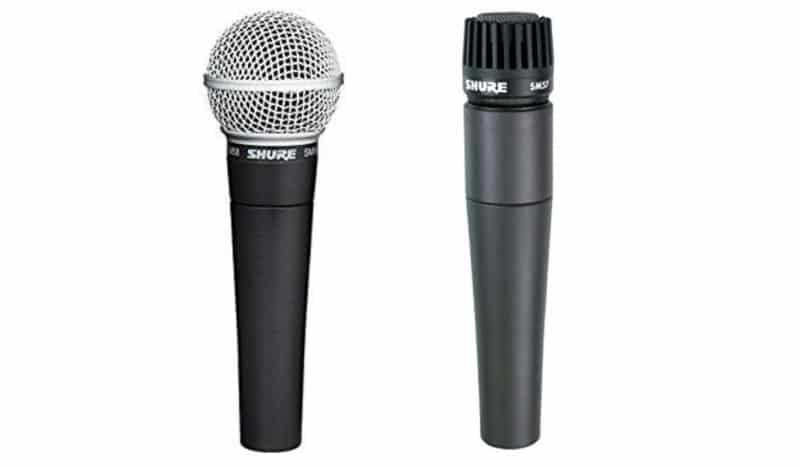
Both of these microphones have been the standard in the recording industry for decades now.
The SM58 is still used to this day in most live events, and in many studio recordings as well.
The same goes for the SM57, which is essentially the same microphone but with a different grille design, which is more commonly used to record electric guitar cabinets, drums, and other instruments.
The Shure SM58 is preferred for vocals because the grille acts as a pop filter, while the SM57 is better for recording instruments since it can be placed slightly closer to those instruments, because of the grille size.
The build quality is just fantastic, nothing could harm these microphones, which is why they are so good for live shows.
Just like with the SM48, the Shure SM57 and SM58 also come with a bass roll-off, which helps control the proximity effect, as well as a mid-boost, to allow the vocals to better cut through the mix.
Find out more about the Shure SM58 and SM57 here:
- Shure SM58: Amazon, Sweetwater.
- Shure SM57: Amazon, Sweetwater.
Sennheiser E609
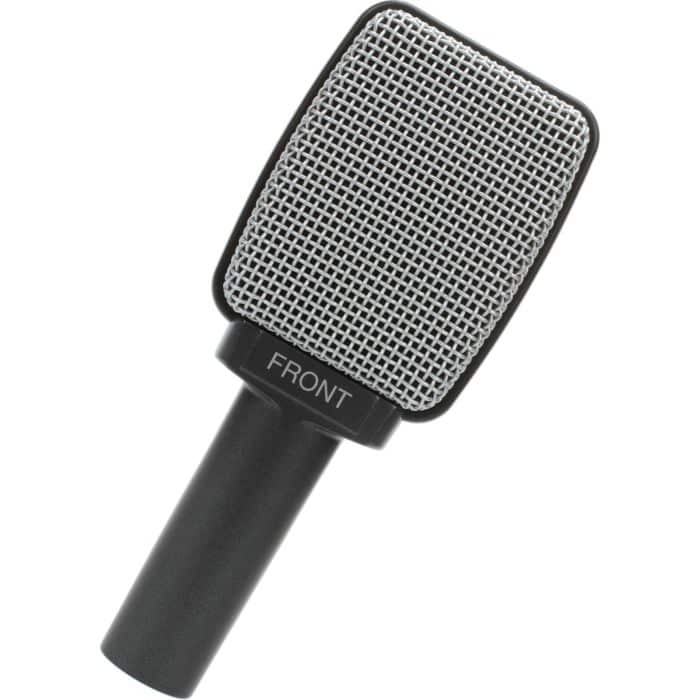
The Sennheiser E609 is a great microphone for recording instruments, especially guitar- and bass cabinets.
This is because of the shape of this microphone since you can hang it from the cabinet, negating the need for a mic stand.
As far as the sound quality goes, especially when recording electric guitar cabinets, it sounds fantastic; The low end is really tight and not muddy at all, while the high end really opens up.
This is a great investment for two reasons; it sounds absolutely fantastic, and it doesn’t require a mic stand which makes it that more versatile.
Find out more about the Sennheiser e609 here.
- Sennheiser e609: Amazon, Sweetwater.
Bass and Kick-Drum Specific Microphones
Some microphones are designed with a specific purpose in mind, and in this case, it’s recording low-frequency instruments.
These microphones, which are dynamic and require an AUdio Interface to be recorded, can both be used to record kick drums and bass guitar cabinets.
Note: The All-purpose dynamic microphones I just listed can also work really well here.
Sennheiser e602-II

This is a neat little microphone that sounds great when inserted inside the kick-drum, especially when placed close to the head where the beater is hitting.
This creates a great-sounding and punchy recording that helps the kick-drum to better cut through the mix.
Like all dynamic microphones, it can withstand almost anything… it can take a beating and still sound great!
It also features a low-end enhancement that is designed to bring out the details on the lower frequencies.
Find out more about the Sennheiser e602-II here.
- Sennheiser e602-II: Amazon, Sweetwater.
AKG D112 MKII
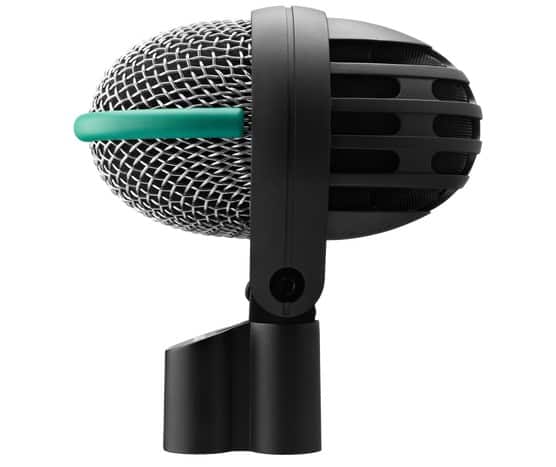
The AKG D112 MKII is probably the most used kick-drum mic of all time.
It’s an industry standard for people who are on a budget but who don’t want to sacrifice the quality of their sound.
It’s built like a tank, it sounds great, what’s not to like?
Not only is it the go-to kick-drum microphone, but a lot of people also use it to record electric bass cabinets with great success.
Blending the recorded bass signal with a direct signal can yield amazing results, which simply adds some flexibility to your tone.
If you have the budget, definitely go with this one since you will never need to upgrade.
Find out more about the AKG D112 MKII here.
- AKG D112 MKII: Amazon, Sweetwater.
Shure Beta 52A

If you really want to purchase a microphone that won’t need to be replaced EVER, then the Shure Beta 52A might be for you.
To be honest, you could certainly get the AKG D112 MKII and get the same quality recordings.
The build quality is excellent, like all Shure products, even better than the one of the AKG 112 and the Sennheiser e602-II, and it’s super heavy.
Right out of the box it already sounds quite good, but add some EQ, compression and a Gate and you will be impressed.
Find out more about the Shure Beta 52A here.
- Shure Beta 52A: Amazon, Sweetwater.
Multi-Pattern Microphones
Multi-pattern microphones are the ones that feature more than one polar pattern, such as cardioid, omnidirectional, bidirectional, etc.
These are very versatile microphones that allow you to record in many different ways, like using the Mid/Side Technique, where you combine a cardioid microphone with a bidirectional one to create a stereo recording.
Note: Again, these microphones require an Audio Interface and Phantom power to be recorded properly.
MXL 770X
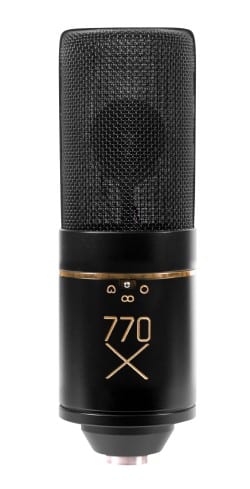
The polar patterns that the MXL 770X has to offer are; Cardioid, omnidirectional and Bi–directional.
It also features a -10dB PAD which comes in handy if you’re recording a really loud source and a High-Pass Filter.
A huge pro about this mic, especially for beginners, is that it comes with an XLR cable, Shock Mount, Pop Filter, and a microfiber cleaning cloth.
The MXL 770X is the multi-pattern mic I’d recommend the most simply because it’s so cost-effective.
It sounds amazing and it comes with a lot of extras…
So, it’s definitely worth checking out.
Find out more about the MXL 770X here.
Behringer B-2 Pro
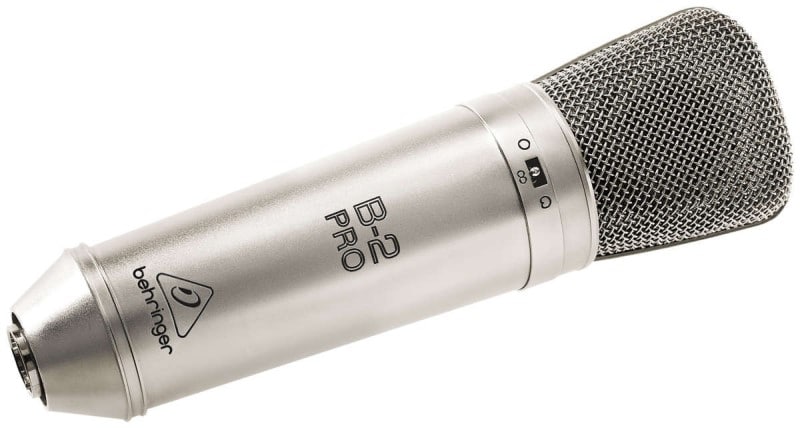
Just like with the previous mic on this list, the Behringer B-2 Pro also features three different polar patterns that can be independently selected.
These patterns are; Cardioid, Omnidirectional, and Bi–directional (figure eight).
It also comes with a PAD switch and a high-pass filter!
The build quality is pretty good, comparable to the XML 770X, and the Behringer B-2 is a good alternative for anyone who wants to add another microphone to their collection.
It comes with a very high-quality aluminum storage case, a shock-mount, and a foam windscreen (not as good as a regular pop filter), and the audio quality is also very good.
The only con I found is that since it has a high-frequency boost, it can end up sounding kind of shrill, which I really don’t like that much.
This is why I wouldn’t recommend it AS much to record something like an acoustic guitar.
When recording electric guitar, especially with distortion, it sounded fantastic!
The issue with this high boost is that it can accentuate breath noises, and mouth noises, and it may sound more sibilant.
All in all, it’s a very good microphone considering the price.
Find out more about the Behringer B-2 Pro here.
- Behringer B-2 Pro: Amazon, Sweetwater.
Audio-Technica AT2050
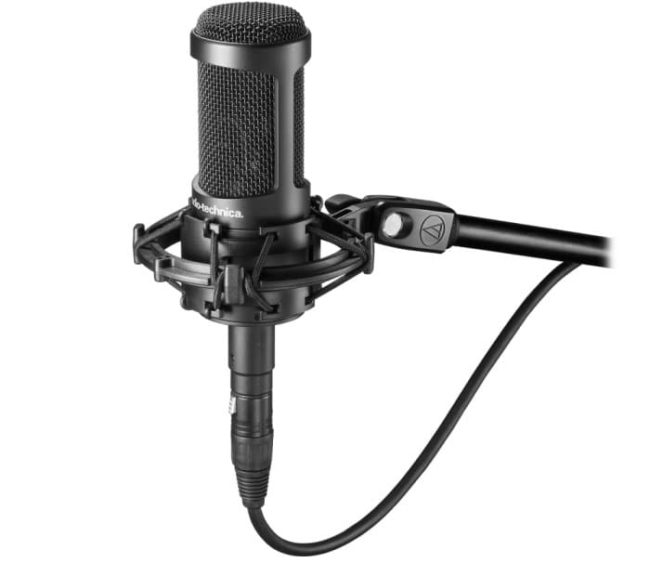
Just like all the other Audio-Technica microphones I listed, the AT2050 has an amazing build quality.
When you look at the front you can see a switch that will allow you to choose between three different polar patterns: Cardioid, Omni–Directional, and Bi–Directional.
On the back, you will find a -10dB PAD and a High-Pass Filter that will roll off lower frequencies from 80Hz downwards.
This is the best multi-pattern microphone on this list, and if you can get your hands on one, I’d highly recommend it.
Find out more about the Audio-Technica AT2050 here.
- Audio-Technica AT2050: Amazon, Sweetwater.
What microphone type you should use depending on what is being recorded
Every instrument is generally recorded in a certain way with specific mics.
If you like the way a dynamic microphone makes your acoustic guitar sound, then by all means, use that one.
But here is a general guideline…
Recording Vocals
In general, Large Diaphragm Condenser microphones and Dynamic microphones, are the ones best suited for this task;
Most people should go with the Rode NT1-A because of how much value it offers.
Otherwise go with the Audio-Technica AT2020 which, to the untrained ear, will sound identical.
Lastly, if you plan on also doing some live gigs, the Shure SM58 is a fantastic choice.
If you decided to go for a USB mic instead, then get the Audio-Technica AT2020+ for vocals.
Recording Acoustic- and Classical Guitar
The best recordings of acoustic guitars are generally done with stereo pair microphones, which are just two small-diaphragm condenser mics.
The best one would be the Avantone CK-1.
Note: You would need to purchase two since they don’t sell in pairs, which can be quite pricy.
If you just want to try out a pair to see how you like it without breaking the bank, then the Neewer NW-410 is your next best bet.
Another typical way of recording acoustic and classical guitar is by using one large-diaphragm condenser microphone.
In this case I’d recommend the same two I recommended for the vocals; The Rode NT1-A and the AT2020.
When it comes to choosing a USB mic to record acoustic and classical guitars, definitely go with the Blue Yeti since it provides the Stereo pattern.
Recording Piano
Pianos are typically recorded with stereo pairs.
My recommendations would be the same stereo pair microphones I listed for acoustic and classical guitar.
Recording Electric Guitar
I already mentioned earlier that electric guitar cabinets tend to be recorded using dynamic microphones.
The two that I recommend are the Shure SM57 and the Sennheiser E609.
Recording Bass Guitar
Even though most of the time people record bass directly on to the DAW, sometimes it’s great to use a real amp with a good mic.
If you decide to go for this option, then I’d recommend the AKG D112 MKII for the simple fact that it sounds absolutely fantastic and is very cost-efficient.
Recording Drums
Drums are a bit more complicated since you need loads of microphones to properly mic it up.
If you want the simplest solution, then just get a stereo pair like the Behringer C-2 and use them as overheads.
Another great alternative is to use a cardioid large-diaphragm condenser microphone and place it right in front of the drum kit.
Any of the stereo pairs and condenser microphones I mentioned will work perfectly.
If you want to properly mic up an entire drum kit, then you will need a lot of dynamic microphones as well as a stereo pair to be used as overheads.
Versatility
If you need a really versatile microphone, then I’d recommend a multi-pattern one.
The Blue Yeti, if you decided to go for a USB mic, or the MXL 770X if you want an XLR mic.
The best three microphones for absolute beginners
These are the microphones that I’d recommend to anyone who is on a tight budget and is a complete newbie;
The Audio-Technica AT2020 simply because it sounds extremely good and is very affordable. Remember that this one is an XLR microphone, which means that you’ll need an Audio Interface with Phantom Power.
The Blue Yeti for its versatility and overall cost-efficiency (USB microphone).
The Shure SM58; Again, you will need an Audio Interface to record with this one. The great thing is that it can also be used for live performances since it’s a dynamic microphone.
Types of Microphones and their Uses
The types of microphones generally used in recording studios, especially home studios, are Condenser and Dynamic microphones, but there are also Ribbon mics, which have their place.
Condenser Microphones
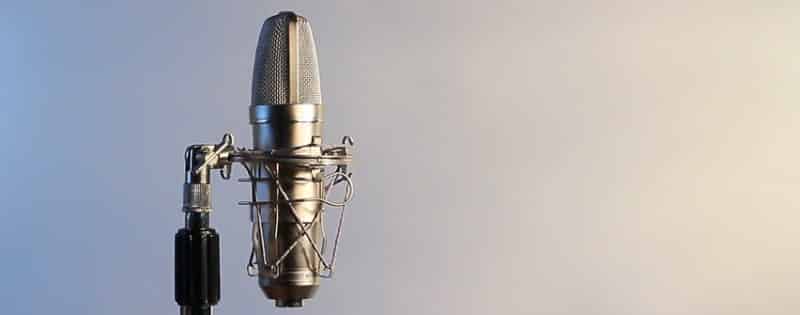
Condenser microphones can have large or small diaphragms.
Large-diaphragm condenser mics are the ones you generally see vocalists using in a studio environment since they are excellent for recording vocals.
Small diaphragm condenser mics, often called pencil microphones, are generally used to record instruments such as acoustic guitar, piano, drum overheads, etc.
Good for recording High Frequencies
Condenser microphones are better at recording higher frequencies because of how small and light the capsule is, meaning that smaller soundwaves -like the ones generated by high-pitched sounds-, will be recorded more easily.
Dynamic Microphones

Dynamic microphones use a wire coil and magnet to create the audio signal, and the diaphragm is attached to the coil.
The soundwaves make the diaphragm vibrate, and this makes the coil move forwards and backwards past the magnet, generating current.
Good for recording Lower Frequencies
Low-frequency waves are bigger and generate more energy than the higher ones.
This means that they can make the coil inside the dynamic mic move much easier.
This is why dynamic microphones tend to be used, in general, to record guitar cabinets, drum kits, etc.
Internal Circuitry
Since the diaphragm in a condenser mic is so small, it can’t generate enough voltage through movement alone.
Dynamic microphones are capable of this because of their larger mass, but condensers aren’t.
This is why Condenser Microphones are called “active” microphones because they require an external power source called “phantom power” to amplify the voltage.
There is a benefit to this; thanks to phantom power, condenser mics can achieve higher gain.
This means that they can record softer sounds more clearly, something that dynamic mics can’t do as well.
Microphone Polar Patterns
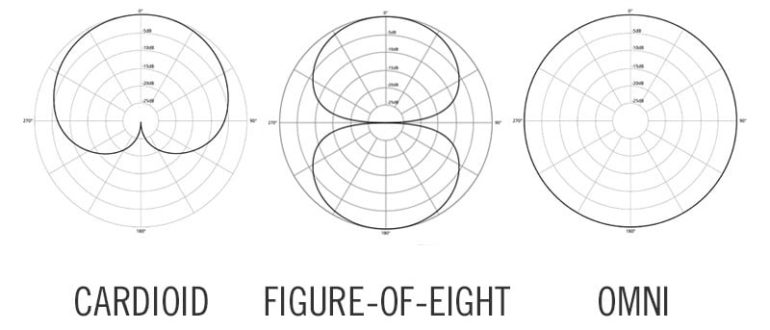
Cardioid is very directional and only picks up sound from the front while rejecting sounds coming from the sides and the back.
Supercardioid is even more directional, meaning that it will pick up even less sound from the sides, but a little more from the back, than the cardioid pattern.
Omnidirectional means that it will pick up sound from every direction.
Bidirectional, or figure 8, picks up sounds in a figure 8 pattern.
99% of the microphones you will ever use in your home studio, or even for podcasting, creating YouTube videos, etc. especially if you’re a complete newbie, will have a cardioid polar pattern.
There’s no need to get too fancy…
Durability
Dynamic microphones win here by a mile…
The lighter diaphragms in condenser microphones are more fragile, which means that higher Sound Pressure Levels (SPL) can damage them.
Dynamic microphones have virtually no SPL limit, which is why they are ideal for recording loud sources.
Not only are their diaphragms stronger, but so is their overall design.
If you drop a condenser mic on the ground… say goodbye to its diaphragm, while on the other hand, you could drop a dynamic mic several times and it will still sound perfect.
Gain before generating Feedback
Dynamic mics are less prone to feedback because they are less sensitive than condenser mics.
This is the reason you see them on live shows so much.
So, if you’re a complete beginner and are looking for a mic to record at home but also to use during band practice or live shows… get a dynamic one.
PAD and High-Pass filter
Some of the microphones on this list also provide a PAD and/or a high-pass filter (HPF), which can be really useful.
While not essential, both can help you achieve better sounding recordings.
A PAD simply reduces the level of the incoming signal to stop the microphone circuitry from overloading and distorting.
Basically, you use it to record really loud sources.
A High-Pass filter, often called low-cut, attenuates the lower frequencies and lets the higher ones through.
The HPF is useful when you’re recording and there’s some low-frequency rumble going on, like the sound of an air-conditioner, which you want to keep out of the recording.
Engaging the HPF will get rid, or at least attenuate, of those kinds of sounds.
Prices
The difference in price is quite a lot actually…
Dynamic mics are generally a lot more affordable ranging from $20 to about $500.
Condenser mics, on the other hand, start out pretty cheap as well but the higher-end ones can cost over 5 grand each.
The great thing is that there are plenty of high-quality options out there at a very affordable price.
There’s no need to break the bank in order to sound great!
Which one is better?
Both microphone types have their place.
Many seem to think that condensers are the BETTER alternative for home studios, but this isn’t true at all.
Dynamic microphones are more durable and are way better for live performances, but they can record music just as well as condensers can.
It all depends on what you are recording and what kind of sound you are going for.
If you’ve ever been to a music studio, then you know that they use a wide variety of microphones, and for good reason.
No ONE mic is perfect at recording everything.
That’s why it is advisable to own a couple and use them accordingly.
Lastly, let’s take a quick look at another category of mics…
Ribbon Microphones

Ribbon microphones have their place and shouldn’t be ignored, but I wouldn’t recommend them for absolute beginners.
They use an aluminum ribbon instead of a diaphragm to capture sound.
These microphones have excellent high-frequency sensitivity and are generally described as being able to capture sound exactly the way our ears hear it.
The reason I’m not recommending them for beginners is their high price tag, plus they suffer from a very strong proximity effect.
This means that when you get close, you are getting a big bass boost that can be hard to manage.
Conclusion
I know this is an extensive list where I talk about a lot of microphones, but I hope you now have a better understanding of which one to purchase that will suit your needs.
The last three I just listed are great for any beginner, just remember that with USB microphones you can only record one track at a time.
If you want to do some multi-track recording, like recording acoustic guitar and vocals simultaneously, then an affordable audio interface plus two microphones like the AT2020 can be a great place to start.
I hope you have a wonderful day!
